Stations of the Cross and Mary
Stations of the Cross and Mary
Q: Why is Mary included in the fourth and thirteenth Stations of the Cross since there is no specific biblical reference to this?
A: The Stations of the Cross as we know them today became a fixed method in the seventeenth century. However, elements of the custom to follow Christ’s footsteps along the path of his final journey can be traced to the beginning of Christianity. The path became known as the Via Dolorosa, the way of dolors (of anguish, grief, sorrows) although the term is not found until the end of the sixteenth century (Via Sancta by the poet Juan de la Enzina 1519?).
The early references to Christ’s final path are found in the letters of pilgrims to the Holy Land who tried to locate the places referred to in Sacred Scripture, such as the Mount of Olives, the sepulcher, the praetorium, the place of the last supper, etc. Later references claim that already at the time of Constantine (since he built the great churches that claimed to be located above them) people came on pilgrimage from all over the then known world to reverence and venerate these places. In the later middle ages, the custom of making an imaginary miniature pilgrimage to the Holy Land developed, especially in England and northern Europe. Altars were set up to commemorate Christ’s final walk. Herbert Thurston, S.J., tells of a chapel of the Holy Sepulcher erected by the Augustinian John von Schaftolsheim in 1378. The chapel had five altars, one dedicated to "alla Madonna dello Spasimo, in memory of our Lady’s anguish when she swooned away on meeting her divine Son.... Another commemorated our Lady’s grief when she received her Son into her arms... a fourth to our Lady ‘delle Gratie’(of grace)." (p. 11)
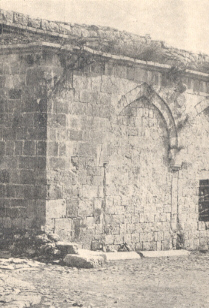
The site of the first fall (station III)
An article in A Dictionary of Mary, by Donald Attwater (pp. 281-2) states:
This curious name – [Swoon of Our Lady] sometimes made more curious in English by being called the “Spasm” (Lat. Spamus) – developed at Jerusalem in the middle ages. An apocryphal writing (q.v.) called the Gospel of Nicodemus makes much of Mary’s agony during her Son’s passage to Calvary; and the idea grew up that when she met him on the way she fainted. This idea perhaps contributed to the development of devotion to Mary’s sorrows. This alleged happening was naturally associated with the traditional site of the fourth station in Jerusalem, and at least since the twelfth century, there has been a church there called St. Mary of the Swoon. The present building is modern, built for the Catholics of Armenian rite.
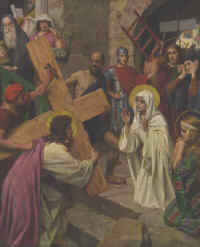
An example of devotion to Christ’s passion and death in union with Mary’s compassionate sorrows is found in Thurston’s writing. He tells of a legend of Blessed Henry Suso, Dominican mystic, as early as 1326, who every night after matins began a type of spiritual pilgrimage that began with the Last Supper. Suso would begin in the chapter room and progress along four streets.
“When he came to the fourth street, he kneeled down in the middle of the road, as if he were kneeling in front of the road through which the Lord must pass out, and then falling on his face before him he kissed the ground, and crying out to him, prayed him not to go to death without his servant but to suffer him to go along with him. Then he pictured to himself as vividly as he could that the Lord was obliged to pass quite close to him, and when he had said the prayer, ‘Ave, rex noster, Fili David!’ (Hail, our King, Son of David) he let him move onwards. After this he knelt down again, still turned towards the gate, and greeted the cross with the verse, ‘O crux ave, spes unica’ (Hail, O Cross, our only hope!) and then let it go past. This done, he kneeled down once more before the tender Mother Mary, Heaven’s Queen, as she was led past him in unfathomable anguish of heart; and he observed how mournfully she bore herself, and noted her burning tears and sighings and sorrowful demeanor, and addressed her in the words of the 'Salve Regina’ and kissed her footsteps. Then he stood up and hastened after his Lord until he came up with him.” (p. 15)
Thurston’s research indicates that the earliest forms of the Stations of the Cross walked the Lord’s final path with Mary. For instance:
“In the narrative of Felix Fabri (1480) we find an elaborate account of the long and wearisome pilgrimage to all the holy places of Jerusalem, made each day by our Blessed Lady while she remained on earth, the manner, duration and extent of her journey being, strange to say, the exact counterpart of that which was compulsorily followed by the pilgrims of the fifteenth century. As this, according to popular tradition, would have been the earliest example of the Way of the Cross.... (p. 23)
“The first traces of the legend of our Lady’s pilgrimages in Jerusalem are of early date. Thus a Syriac recension of the apocryphal departure of my Lady Mary from the world, which is assigned on high authority to the fifth century records:
‘In the year 345 (of the Seleucian era, i.e., A.D. 34), in the month of the latter Teshrin, my Lady Mary came forth from her house and went to the tomb of the Messiah, because day by day she used to go and weep there. But the Jews, as soon as the Messiah was dead, closed the tomb and heaped up large stones against its door, and set watchmen over the tomb and Golgotha, and gave them orders that if any one should go to pray by the grave or on Golgotha he should straight-way die . ... And the watchmen came in and said to the priests, ‘Mary comes in the evening and in the morning, and prays there.’ And there was a commotion in Jerusalem concerning my Lady Mary; and the priests went to the judge and said to him, ‘My Lord, send and order Mary not to go and pray at the grave and Golgotha'." [Source: “The Departure of my Lady Mary from this world,” translated from the Syriac by Dr. William Wright, Journal of Sacred Literature, April 1865. This account is copied from a MS. of the sixth century.]
“In a Latin adaptation of what is substantially the same story, printed by Tischendorf, a larger scope is give to our Lady’s devotional pilgrimage. This account states that: ‘When the apostles had separated in order to preach the gospel and had traveled to different parts of the world, the blessed Virgin, our Mother, is said to have remained in Jerusalem in a house which was situated close to Mount Sion. Thence, as long as she lived, she used to visit every spot which her Son’s presence had sanctified, the place of his baptism, of his fast, of his passion, resurrection and ascension.’
“The legend gradually developed, and in the thirteenth century we begin to hear of a definite spot near the Church of the Ascension where our Lady used to rest....
“...Fabri’s account of our Lady’s pilgrimage, conveying as it does a truthful impression of the devotional spirit of the age at which the exercise of the Stations took its rise, deserves to be cited at some length. I quote from the translation of this extremely interesting book published a few years since by the Palestine Pilgrims’ Text Society.
‘Our blessed Lady was careful every day to visit the holiest places in Jerusalem and the neighborhood. In the early morning, as dawn drew nigh, after having received holy Communion from St. John on the Lord’s Mount of Sion, she went forth with her maidens and entered that great chamber which had been made ready for the Last Supper, where she meditated upon the immense boon there conferred upon the human race, looked into the deepest mysteries, and kissed the place where her Son had sat. From thence she would go to the house of Annas the high priest, and after praying there entered the hall of Caiphas, and mused, not without sorrow, upon the sufferings undergone by her Son in that building. Thence she went down from Mount Sion out of the city and came to the rock of the Cross, which she embraced and sweetly kissed, pitying that dearest One who was crucified thereon, and rejoicing nevertheless in his precious devotion to those who he redeemed. From thence entering into the garden of the Lord’s tomb, she would go to the place where the Body of her Son and Lord was anointed and preserved in spices, where she kneeled and kissed the stone, and swiftly rising from thence, made her way to the Lord’s tomb, whose cave she entered, and embracing his sepulcher, was filled on that spot with unspeakable joy. Leaving these places, she went down the hill of Calvary towards the city gate, and on her way, not unmindful of her son, how he was led out of the city along that path, burdened with the heavy Cross, and in the places where she had seen her Son either fall beneath the load of the Cross or be assailed by some special outrage, she would kneel down and pray. Thus she would enter the city by the Judicial Gate (per portam judiciariam), go up to Pilate’s judgment hall, and kiss the places where he was scourged and crowned with thanksgiving. Coming out from thence, she would go to the house of Herod and kiss her Son’s footprints there. From thence she would go up to the temple of the Lord, and after praying there, would leave the temple on the other side, and come to the Golden Gate, where she reflected upon her Son’s entrance on Palm Sunday.’ [Fabri (P.P.T.S.), vol. I, pp. 505, 506.]
‘... and [she] went on till she came to the dwelling where already, at the outset of this pilgrimage of the most Blessed Virgin Mary, I have said was her place of rest and recovery of breath. Now at the time when the blessed Virgin Mary was alive there stood a dwelling, inhabited by good peasants, who, observing her to sit and refresh herself in the shade. She frequently would come out of the road, sit down and rest her frail maiden limbs.’
From this rough resting-place Brother Fabri describes her as rising:
"So having resumed her strength, which she had not lost, but which had been in abeyance at the aforesaid place, she came down the foot of the mount into the valley, where after visiting the sepulchers of some of the prophets, she came to the sepulcher of her own most chaste husband, Joseph, who was buried there in a cleft of a rock.... " (p. 33)
According to the Thurston research this route supposedly taken by Mary was followed by pilgrims from 1350-1530. An English pilgrim, Master William Wey 1458 / 1462 writes of having followed the Stations in this sense. Thurston points out “the wide divergence between the Stations in Jerusalem itself, as known to travelers between 1300 and 1720, and those of our modern Way of the Cross” by drawing up a table which records “the dates of the principal narratives and all the sites mentioned in them.” (p. 58)
An example of the devotion from this period in found in the narrative of Master William Wey, “one of the original fellows of Eton College” who visited Palestine in 1458 and again in 1462.
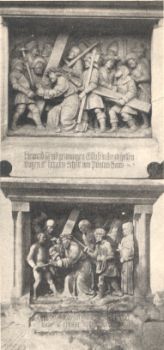
The second and fifth stations, carved by Adam Krafft at Nuremburg
"On both occasions he went to Jerusalem, and made the ordinary round of the holy places (through the city, and to the Mount of Olives and back), under the guidance of the Franciscans of Mount Sion.” (p. 46) In his book, Wey copied another account at Jerusalem in English verse. This is seemingly of older date than his own.
Ther JHESU mett with his Modyr MarieTher sorowyd together both He and she;And ther the wymmen of JerusalemWept on CHRYST when that He cam.” (p. 51)
Fifty years later, Sir Richard Guylforde writes:
“[2] The next place y we come to is wher our blessyd Lady stode when she met with her dere Sone berynge His crosse, where, for ouer moche sorowe and dolour of herte, she sodenly fell into a sowne and forgetfulness of her mynde; and this place is called Scta Maria de Spasmo. Saynt Eyyn buylded a churche there, but it is downe, and ye Sarrasyns haue often attempted to buylde there, but their edifying wold not stande in no wyse.” (p. 54.)
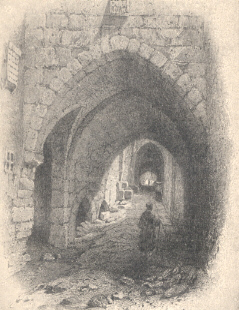
Within the route taken by the pilgrims four variable stations began to appear: the encounters with Mary, Simon of Cyrene, the women and Veronica. The tradition of the number of stations as fourteen and the events of the stations was finalized by the sixteenth century (Antwerpen 1526). Instead of the long journey thought to have been taken by Mary, the fourteen stopping points represent Christ’s suffering (from the Antonia Fortress to Golgotha) and to the tomb. A tradition closely related to the stations and probably mutually influencing their development is the devotion of the seven falls. Adam Krafft of Nuremberg completed eight sculptures, probably completed before 1490, that depict Christ falling seven times on the route to Calvary. His first station reads: “Here Jesus meets his dear and Blessed Mother, who swooned away for anguish of heart, two hundred paces from Pilate’s house.” The last of these falls, Jesus laid in the arms of his Blessed Mother. (Pp. 63-64) Only half of the stations are supported by biblical texts. The others evolve from tradition. The meeting with Mary, her place at the foot of the cross, and the deposition, that is, Christ being laid in her arms when taken from the cross, are based on the passages John 19, 25-27. Traditions of the fourth station sometimes relate that Mary fainted (swooned) when she first saw her suffering son as she made her way to Calvary. Others insist that the scriptures refer to Mary’s inner strength and accompaniment of Jesus because she stood by him under the cross. That Mary would have stayed at the cross until her son was removed, that she would have held him and helped to wrap him in the burial cloth is understood as the commitment such a faithful mother would give. Early English writers sometimes used the word spasmus to describe Mary’s sufferings at the Passion. Her spiritual pain was compared to birth spasms as she stood with her son during his bitter passion and death. Cardinal Newman meditated on the fourth station as follows:
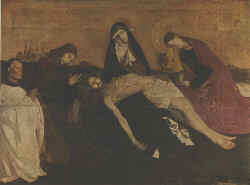
The Via Dolorosa, near Veronica's House, from a drawing by W. Bartlett, c. 1840
Mary would rather have had all his sufferings herself, could that have been, than not to have known what they were by ceasing to be near him. ... He was now carrying the load of the world’s sins, and, all holy though he was, he carried the image of them on his very face. ... what a meeting of Mother and Son! Yet there was a mutual comfort, for there was a mutual sympathy.
Sources:
Research and text, M. Jean Frisk
A Dictionary of Mary, Donald Attwater, P.J. Kenedy & Sons, New York, 1956, 281-2.
Marienlexikon, G.B.Winkler, Vol 3, 669-672.
The Stations of the Cross: An Account of their History and Devotional Purpose, Herbert Thurston, S.J., Burns & Oates, London, 1906.
All About Mary includes a variety of content, much of which reflects the expertise, interpretations and opinions of the individual authors and not necessarily of the Marian Library or the University of Dayton. Please share feedback or suggestions with marianlibrary@udayton.edu.
